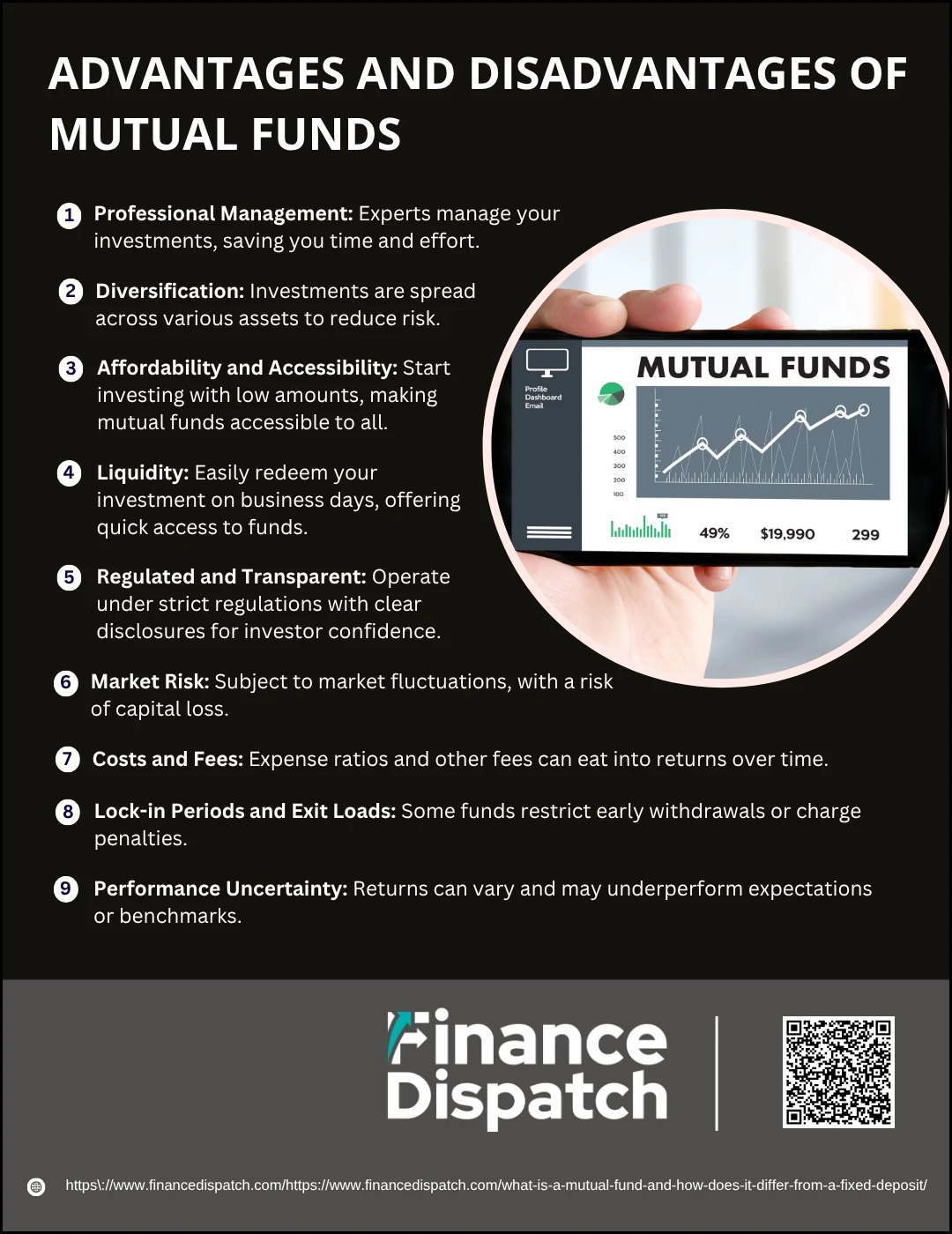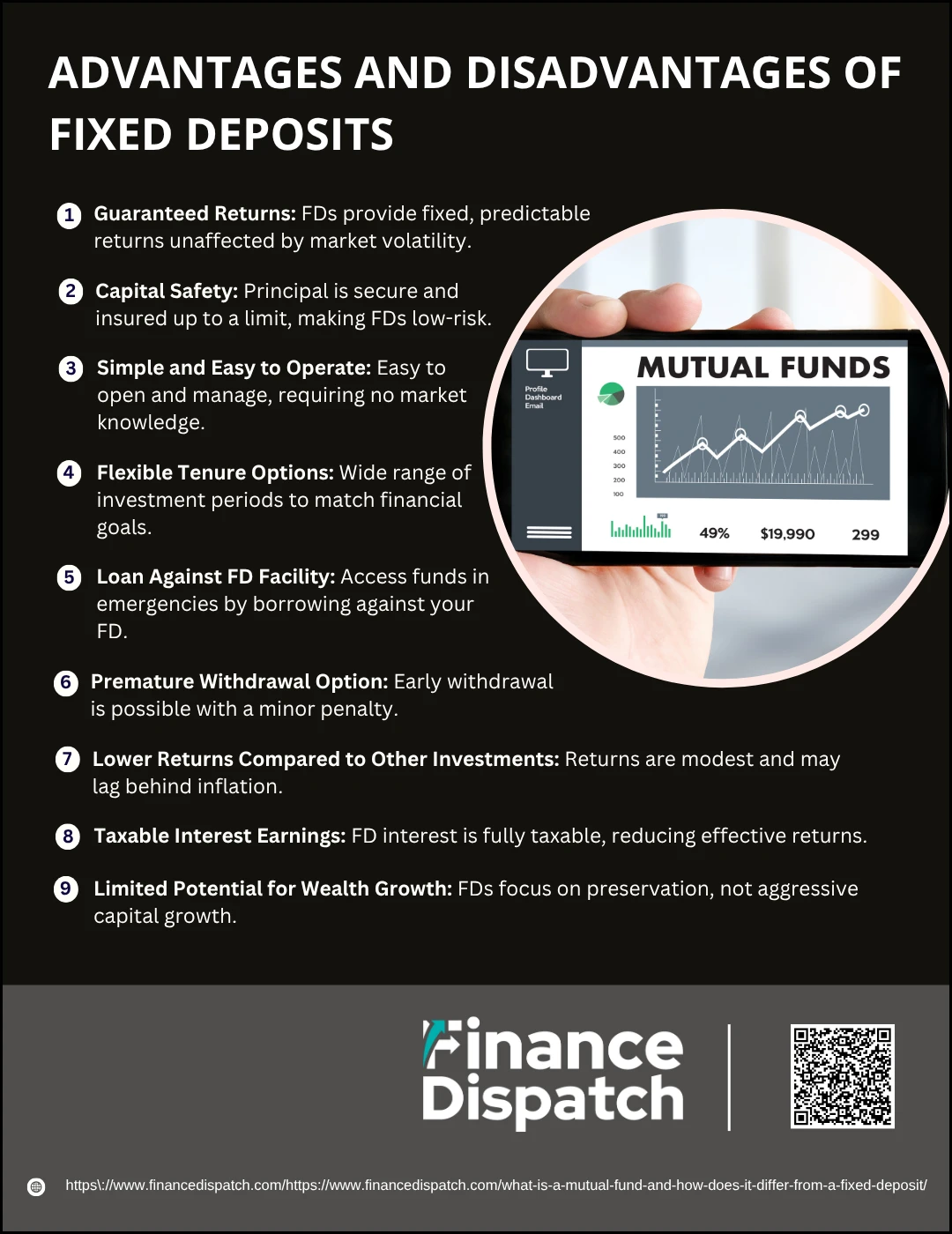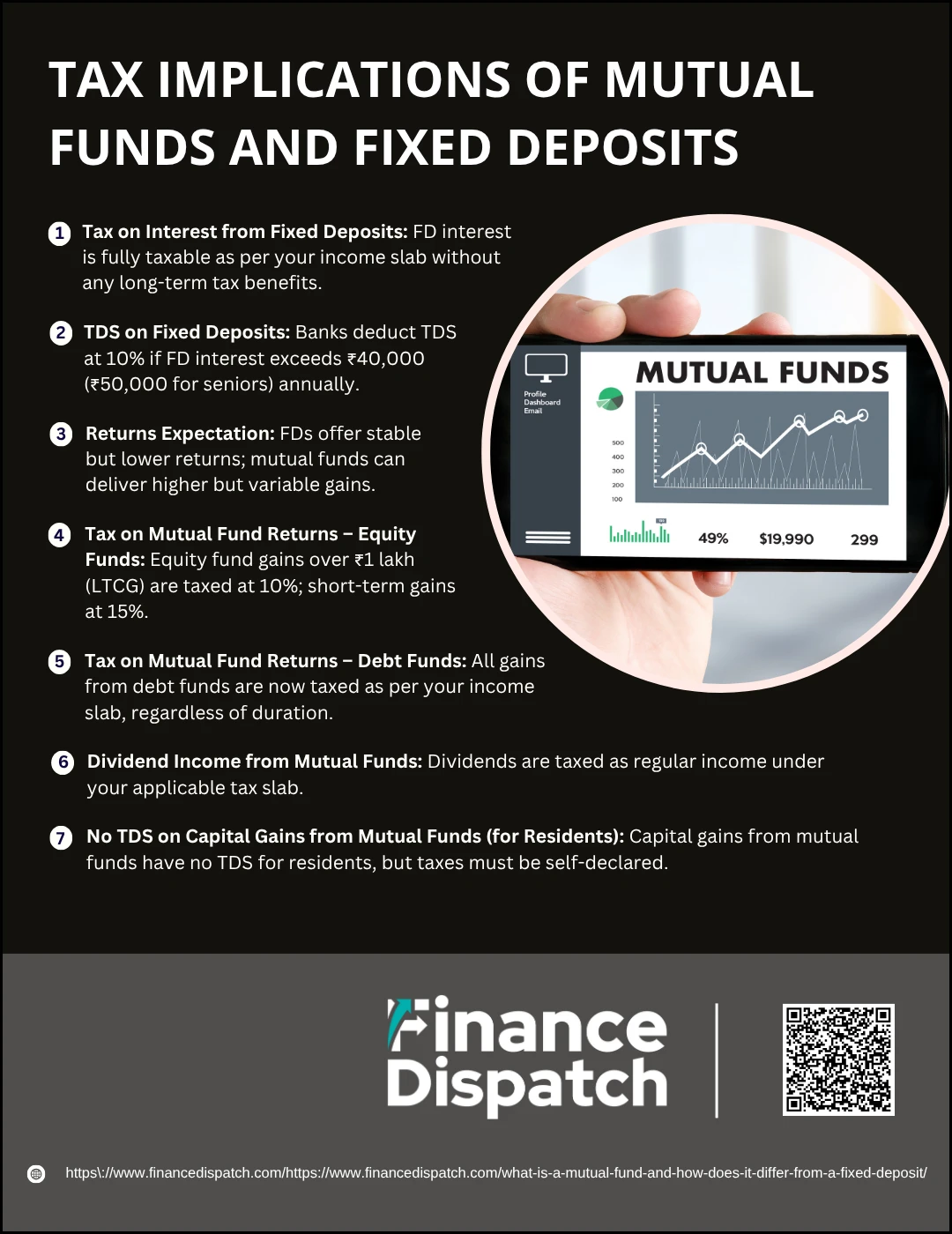When it comes to saving or investing your money, two of the most widely considered options are mutual funds and fixed deposits. While both serve the purpose of helping you grow your wealth, they do so in very different ways. Fixed deposits are known for their safety and predictable returns, making them a preferred choice for conservative investors. Mutual funds, on the other hand, offer the potential for higher gains through market-linked investments but come with a certain level of risk. Understanding how these two instruments work—and how they differ—can help you make smarter financial decisions that align with your goals and risk appetite.
What is a Mutual Fund?
A mutual fund is a type of investment vehicle that pools money from multiple investors to create a common fund, which is then invested in a diversified portfolio of assets such as stocks, bonds, or other securities. These investments are managed by professional fund managers who aim to generate returns based on the fund’s objectives. Unlike fixed deposits, mutual funds do not offer guaranteed returns; instead, the performance is linked to market conditions. This means your investment value can rise or fall depending on how the underlying assets perform. However, the benefit of diversification and professional management makes mutual funds a compelling option for individuals seeking long-term wealth growth with varying levels of risk tolerance.
What is a Fixed Deposit?
A fixed deposit (FD) is a traditional and secure savings instrument offered by banks and financial institutions, where you invest a lump sum amount for a fixed period at a predetermined interest rate. The interest earned is guaranteed and remains unaffected by market fluctuations, making FDs a low-risk option ideal for conservative investors. At the end of the tenure, you receive your initial investment along with the accumulated interest. While premature withdrawals are allowed, they often come with a penalty. Fixed deposits are best suited for short- to medium-term financial goals and for those who prioritize capital preservation and steady returns.
Key Differences between Mutual Funds and Fixed Deposits
When deciding between mutual funds and fixed deposits, understanding their core differences is essential. While both are popular investment options, they cater to distinct financial goals and risk appetites. Mutual funds offer the potential for higher returns but come with market-related risks, whereas fixed deposits provide stability and guaranteed returns, making them ideal for cautious investors. The table below highlights the key differences between the two:
| Feature | Mutual Funds | Fixed Deposits |
| Nature of Investment | Pooled investment in stocks, bonds, or other assets | Lump sum deposit with a bank or NBFC |
| Returns | Market-linked and variable | Fixed and guaranteed |
| Risk Level | Moderate to high, depends on fund type | Low risk, capital is protected |
| Liquidity | High (can redeem anytime; may have exit load) | Moderate (early withdrawal allowed with penalty) |
| Management | Professionally managed by fund managers | No management needed |
| Expenses | Expense ratio (typically 1–2%) | No associated expenses |
| Lock-in Period | Usually none (except ELSS with 3-year lock-in) | Based on chosen tenure |
| Taxation | Capital gains tax based on holding period | Interest taxed as per income slab |
| Ideal For | Long-term wealth creation, inflation-beating returns | Short- to medium-term savings, capital safety |
 Mutual Fund and Fixed Deposits Which One Should You Choose?
Mutual Fund and Fixed Deposits Which One Should You Choose?
Choosing between a mutual fund and a fixed deposit depends largely on your personal financial priorities and investment goals. Each option serves a distinct purpose, and understanding these can help you make a confident and informed decision.
1. Risk Tolerance
If you are someone who prefers safety and cannot afford to lose any portion of your principal, a fixed deposit is the right choice. It offers guaranteed returns and peace of mind. However, if you are comfortable with some level of market risk in exchange for potentially higher returns, mutual funds are more suitable.
2. Investment Horizon
Fixed deposits work well for short- to medium-term goals. Whether you’re saving for a vacation next year or building a buffer for emergencies, FDs are reliable. Mutual funds, on the other hand, are ideal for long-term financial objectives like retirement or building a significant corpus over time.
3. Returns Expectation
If you are satisfied with fixed interest—usually between 5% to 7%—FDs offer that stability. But if you’re aiming to beat inflation and grow your money substantially, mutual funds can offer better returns, albeit with associated risks.
4. Liquidity Needs
Fixed deposits offer limited liquidity. You can withdraw early, but usually with a penalty. Mutual funds, especially open-ended ones, provide much more flexibility—you can redeem your units anytime, often without heavy charges, depending on the fund.
5. Tax Efficiency
Interest earned from fixed deposits is fully taxable under your income slab. In contrast, mutual funds have varying tax treatments. Equity mutual funds offer long-term tax advantages, making them more efficient in many cases, especially when held for more than a year.
6. Management Involvement
FDs require no active attention once invested. Mutual funds are managed by professional fund managers, making them an attractive option for individuals who lack the time or expertise to track the market but still want exposure to higher growth potential.
7. Financial Goals Alignment
If your goal is wealth preservation and steady income, fixed deposits are the way to go. But if you’re planning for future milestones and can allow your money to grow with the market over time, mutual funds are better suited.
 Advantages and Disadvantage of Mutual Fund
Advantages and Disadvantage of Mutual Fund
Mutual funds are widely regarded as one of the most accessible and effective ways for individuals to invest in the financial markets. By pooling money from multiple investors, mutual funds allow people to gain exposure to a diverse set of assets—such as equities, bonds, or hybrid instruments—without the need for large capital or deep investment knowledge. They are professionally managed, relatively liquid, and come in a variety of risk-return profiles to suit different investment goals. However, despite their many advantages, mutual funds are not without drawbacks. Investors must be aware of the costs, potential for market losses, and other limitations before committing their money. Below is a deeper look at the key advantages and disadvantages of investing in mutual funds.
1. Professional Management
One of the biggest benefits of mutual funds is that your investment is managed by skilled professionals. Fund managers make research-backed decisions about where to invest your money, handle asset allocation, and monitor performance. This is ideal for investors who lack the expertise or time to actively manage their own investments.
2. Diversification
Mutual funds automatically spread your investment across a wide range of assets, such as different companies, sectors, or even countries. This diversification helps reduce the risk associated with individual securities, as poor performance in one investment may be offset by better performance in another.
3. Affordability and Accessibility
Mutual funds are highly accessible. You can start investing with relatively low amounts, especially through SIPs (Systematic Investment Plans), which allow you to invest small sums regularly. This makes mutual funds suitable for both small and large investors.
4. Liquidity
Most open-ended mutual funds offer high liquidity, allowing you to redeem your units on any business day at the prevailing Net Asset Value (NAV). This ease of entry and exit is useful when you need quick access to your funds, although exit loads may apply in some cases.
5. Regulated and Transparent
Mutual funds are strictly regulated by authorities like SEBI, ensuring that fund operations are transparent and adhere to standardized practices. Fund houses must disclose NAVs, portfolio holdings, fees, and performance data regularly, which helps investors stay informed.
6. Market Risk
While mutual funds aim to deliver returns, they are not risk-free. Their value can fluctuate based on market movements, interest rate changes, economic conditions, and other factors. Equity funds, in particular, are highly sensitive to market volatility, and there is always a chance of losing part of your capital.
7. Costs and Fees
Mutual funds charge an expense ratio, which includes fund management fees and other operational costs. Over time, these fees can reduce your overall returns, especially in actively managed funds with higher cost structures.
8. Lock-in Periods and Exit Loads
Certain mutual funds, such as tax-saving ELSS (Equity Linked Savings Schemes), come with a mandatory lock-in period (typically three years). Additionally, some funds charge exit loads if you redeem your investment within a short period, limiting your ability to withdraw freely.
9. Performance Uncertainty
Despite professional management, there is no guarantee of consistent performance. A fund’s returns depend on market conditions and the fund manager’s skills and strategies. Some funds may underperform their benchmarks or peers, even during favorable market conditions.
 Advantages and Disadvantage of Fixed Deposits
Advantages and Disadvantage of Fixed Deposits
Fixed deposits (FDs) are among the most trusted and widely used investment options. Offered by banks and financial institutions, FDs allow you to invest a lump sum for a specified period at a predetermined interest rate. This makes them an ideal choice for conservative investors who value stability over high returns. The predictability of returns, combined with capital safety, makes FDs particularly attractive for those nearing retirement, individuals with low-risk appetite, or anyone planning for short-term financial goals. However, while FDs provide financial assurance, they also come with certain limitations such as low liquidity and lack of tax efficiency. Understanding both the advantages and disadvantages will help you assess if fixed deposits are the right fit for your investment strategy.
1. Guaranteed Returns
One of the biggest advantages of a fixed deposit is the certainty of returns. Once you invest your money at a fixed interest rate, the return is unaffected by market fluctuations. This makes FDs a secure way to grow your savings, especially during volatile economic periods when other investment options may not perform well.
2. Capital Safety
FDs are considered a very safe investment. Your principal amount is not exposed to market risks. Moreover, deposits of up to ₹5 lakh per account holder in each bank are insured under the DICGC scheme, adding an extra layer of protection in case of a bank’s financial failure.
3. Simple and Easy to Operate
Opening and managing a fixed deposit is extremely straightforward. There is no need to track market movements or understand complex financial products. This simplicity makes FDs ideal for first-time investors, senior citizens, and those who prefer low-maintenance investments.
4. Flexible Tenure Options
FDs offer a wide range of tenure choices, from as short as 7 days to as long as 10 years. This flexibility allows investors to align their investment with their financial goals—whether it’s for a vacation next year, a child’s education in a few years, or general savings.
5. Loan Against FD Facility
In times of financial emergencies, you can avail a loan against your FD, typically up to 90% of the deposit amount. This allows you to access funds without breaking your deposit, ensuring that the interest continues to accrue while meeting your short-term cash needs.
6. Premature Withdrawal Option
Although fixed deposits are designed to be held until maturity, most banks allow premature withdrawal with a small penalty. This offers a backup plan in case you urgently need money, adding a layer of financial flexibility.
7. Lower Returns Compared to Other Investments
FDs generally offer lower returns than equity mutual funds, stocks, or even some government schemes. Over time, the returns may barely keep up with inflation, which means the real value of your money may not increase significantly in the long run.
8. Taxable Interest Earnings
The interest you earn from a fixed deposit is fully taxable as part of your income. If your annual interest income from FDs exceeds ₹40,000 (₹50,000 for senior citizens), banks will deduct Tax Deducted at Source (TDS). This reduces the net return, especially for individuals in higher tax brackets.
9. Limited Potential for Wealth Growth
FDs are more suitable for capital preservation than aggressive wealth creation. While they protect your investment, they don’t offer the compounding growth potential that mutual funds or equities might provide over longer periods.
 Tax Implications of Mutual Fund and Fixed Deposits
Tax Implications of Mutual Fund and Fixed Deposits
When evaluating investment options, many individuals focus on returns, risk levels, and ease of access—but often overlook one critical factor: taxation. The tax treatment of your investment can significantly affect your actual earnings. Mutual funds and fixed deposits (FDs) differ not only in how they generate returns but also in how those returns are taxed. While FDs offer fixed, predictable returns, the income is fully taxable. Mutual funds, however, are subject to capital gains tax, which depends on how long you hold the investment and whether the fund is equity- or debt-based. Understanding these tax rules is essential for making informed financial decisions and optimizing your post-tax returns.
1. Tax on Interest from Fixed Deposits
Interest earned from a fixed deposit is treated as “Income from Other Sources” under the Income Tax Act. This means it gets added to your total taxable income for the financial year and is taxed according to the slab rate applicable to you. For example, if you fall under the 30% tax bracket, the entire FD interest will be taxed at 30%, significantly reducing your net earnings. Unlike mutual funds, there is no distinction based on holding period, so there are no tax benefits for long-term FD investments.
2. TDS on Fixed Deposits
Banks are required to deduct Tax Deducted at Source (TDS) if the interest from your fixed deposits exceeds ₹40,000 in a financial year (₹50,000 for senior citizens). The default TDS rate is 10%. If your income falls under a higher tax bracket, you’ll need to pay the difference when filing your income tax return. If your total income is below the taxable threshold, you can submit Form 15G or 15H to avoid TDS deduction.
3. No Indexation or Tax Breaks on FDs
Fixed deposits do not benefit from any inflation adjustment or indexation. This makes them less attractive for long-term wealth growth, as the real returns—after accounting for both tax and inflation—can be significantly eroded. Even tax-saving FDs, which come with a five-year lock-in, only offer deductions under Section 80C (up to ₹1.5 lakh), and the interest remains fully taxable.
4. Tax on Mutual Fund Returns – Equity Funds
For equity mutual funds, the tax treatment depends on how long you hold the investment. If held for more than 12 months, the gains qualify as Long-Term Capital Gains (LTCG) and are taxed at 10%, but only if the gains exceed ₹1 lakh in a financial year. Gains below ₹1 lakh are completely tax-free. If sold within 12 months, Short-Term Capital Gains (STCG) apply, taxed at 15%—a rate generally lower than most individual income tax slabs.
5. Tax on Mutual Fund Returns – Debt Funds
As per the latest tax laws, all gains from debt mutual funds are taxed at your applicable income tax slab rate, regardless of the holding period. Earlier, debt funds held for more than three years qualified for LTCG tax at 20% with indexation benefits, making them more tax-efficient. But now, this advantage has been removed, leveling the playing field with FDs in terms of tax liability.
6. Dividend Income from Mutual Funds
Dividends received from mutual funds were previously taxed through Dividend Distribution Tax (DDT), which was deducted before distribution. However, under the current tax regime, dividends are added directly to the investor’s taxable income and taxed as per their slab rate—just like FD interest. This applies to both equity and debt mutual funds.
7. No TDS on Capital Gains from Mutual Funds (for Residents)
Unlike FDs, mutual fund houses do not deduct TDS on capital gains for resident investors. This means the entire capital gain comes to you without deductions, but you are responsible for declaring it and paying the applicable tax when filing your return. However, TDS does apply for non-resident investors at specified rates.
Conclusion
In conclusion, both mutual funds and fixed deposits serve important roles in an investor’s financial strategy, but they differ significantly in terms of risk, returns, liquidity, and taxation. Fixed deposits are best suited for individuals seeking stability, guaranteed income, and capital protection, especially over short to medium terms. Mutual funds, on the other hand, are ideal for those who can tolerate market fluctuations and are aiming for higher, inflation-beating returns over the long run. While FDs offer tax predictability with fully taxable interest, mutual funds provide more favorable tax treatment, particularly for long-term equity investments. Ultimately, the better option depends on your financial goals, risk tolerance, investment horizon, and tax situation. In many cases, a combination of both can help balance safety with growth, offering a more robust and diversified investment portfolio.



